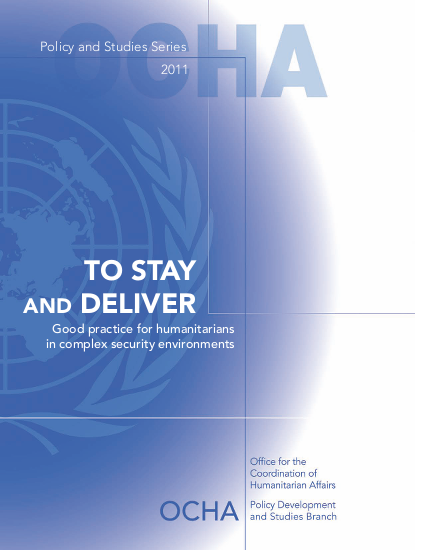
This report synthesises the findings as well as specific inputs and guidance received from the study’s Advisory Group. into security in the humanitarian environment. This was based on six field studies in complex security environments, interviews with 255 humanitarian practitioners and policymakers, and a survey of over 1,100 national staff members, and a desk-based review of organisational literature and case-based evidence. This report synthesises the findings as well as specific inputs and guidance received from the study’s Advisory Group. Presence and proximity to affected populations is the prerequisite of effective humanitarian action. The objective for humanitarian actors in complex security environments, as it is now widely recognised, is not to avoid risk, but to manage risk in a way that allows them to remain present and effective in their work. This shift from risk aversion (or, on the other extreme, recklessness) to risk management represents the culmination of the past decade’s evolution in thinking and methodology for programming in insecure conditions. Key to this shift is the concept of the enabling security approach- an approach that focuses on ‘how to stay’ as opposed to ‘when to leave’ - which has been adopted in the UN system and by many organisations. This mindset in turn depends on organisations and individuals accepting a certain amount of risk - the risk that inevitably remains after appropriate analysis and all reasonable mitigation measures have been carried out. The more critical the humanitarian programme is to people’s survival and well-being, the greater amount of risk may be accepted. This is a conscious and calculated assessment, intended to prevent both recklessness and risk aversion. It is designed to ensure effective accountability within organisations, and also to preclude any scapegoating in the aftermath of a security incident. To date, more evidence of these concepts has been seen in theory and policy than in operations, where they are just beginning to take hold. However, the risk management paradigm has also reinforced - and been reinforced by - certain innovations in the field.
Summary: This study is designed for aid practitioners and their organisations seeking practical solutions to gain, maintain, and increase secure access to assist populations in a range of complex security environments. It aims to enhance the ability of humanitarian actors to provide aid to people in need, even in areas of heightened risk, in a way that is consistent with the core humanitarian principles of humanity, impartiality, independence, and neutrality. It is reasonable to question why—when after all it is the local civilians who suffer most from conflict and violence—a study should focus on the security of aid personnel and operations. Simply stated, where aid workers are attacked, the quality and quantity of aid is reduced, and beneficiaries suffer. It is useful, therefore, to think of ‘secure humanitarian access’ both as enabling affected civilians to access the aid they need in the way they need it, as well as giving humanitarian actors the means to gain access to people and territories. It is a dual process which must ensure that aid does not bring increased risk to beneficiaries. The ultimate aim of the exercise is to support the survival and well-being of people in need.
The research team set out to answer the following questions: What are the salient features of the most insecure contexts for aid operations, and what is the nature of the main threats and challenges to humanitarian access? Are there commonalities in the diverse operational settings and threat environments? What adaptations, innovations, or improvements in current operations have proven useful in the field for gaining or maintaining secure access? Can lessons be drawn and applied by different actors and in different environments? What roles are played by political, military, and non-state actors in facilitating or hindering secure humanitarian access? What are the distinct issues and challenges faced by national aid workers in high-risk settings, independently and in relation to the international community?